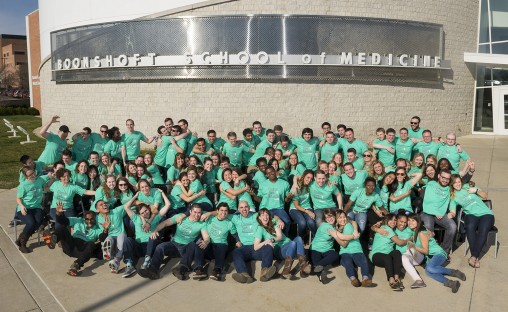Ninety-six medical students of the Wright State University Boonshoft School of Medicine learned today where they will spend the next three to five years of their lives completing residency training after receiving their medical degrees in May.
A longstanding tradition at medical schools nationwide, Match Day is a highly anticipated event. It is the day that medical students learn where they are heading as new doctors to receive advanced clinical training in a residency program.
Surrounded by friends and family in the Apollo Room of the Wright State Student Union, each student waited for his or her envelope to be drawn from a hopper and announced by Dean Margaret M. Dunn, M.D.
In 2015, more than 18,000 U.S. allopathic medical school seniors and 16,000 other applicants vied for more than 30,000 residency positions at institutions nationwide. The 2016 Match is expected to be even larger.

Wright State Boonshoft School of Medicine students matched in outstanding programs in Dayton, throughout Ohio and across the country. (Photos by Will Jones)
Depending on where they match, students will spend the next three to five years as residents receiving advanced training in a primary care field or one of dozens of medical specialties.
Wright State students matched in outstanding programs in Dayton, throughout Ohio and across the country, including Case Western/University Hospitals Case Medical Center, Stanford University Programs, University of Michigan Hospitals, University of Southern California and Wake Forest University.
Almost half (47 percent) of the Wright State graduates will remain in Ohio during residency, and 24 percent will remain in Southwest Ohio.
More than half (52.1 percent) will enter a primary care field (Family Medicine: 10.4 percent; Internal Medicine: 18.8 percent; Internal Medicine/Pediatrics: 4.2 percent; Pediatrics: 18.8 percent).
The rest matched in 13 other specialties: Anesthesiology: 4.2 percent; Dermatology: 1 percent; Emergency Medicine: 11.5 percent; Neurology: 1 percent; Obstetrics and Gynecology: 4.2 percent; Ophthalmology: 2.1 percent; Orthopaedic Surgery: 1 percent; Otolaryngology: 2.1 percent; Physical Medicine and Rehabilitation: 1 percent; Psychiatry: 6.3 percent; Radiology-Diagnostic: 2.1 percent; Surgery: 8.3 percent; and Urology: 3.1 percent.
A complete list of all matches is available at medicine.wright.edu/match.













 Top 10 Newsroom videos of 2025
Top 10 Newsroom videos of 2025  Museum-quality replica of historic Hawthorn Hill donated to Wright State
Museum-quality replica of historic Hawthorn Hill donated to Wright State  Wright State celebrates more than 1,000 graduates at fall 2025 commencement
Wright State celebrates more than 1,000 graduates at fall 2025 commencement  2026 Alumni Achievement Awards celebrate distinguished Wright State community members
2026 Alumni Achievement Awards celebrate distinguished Wright State community members  Bags, boards and bonding
Bags, boards and bonding 